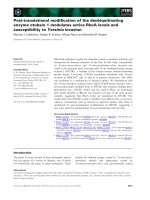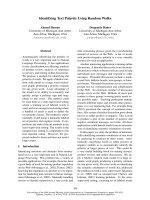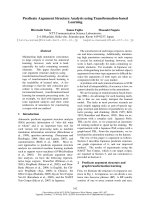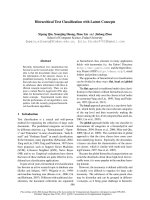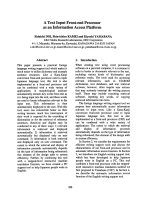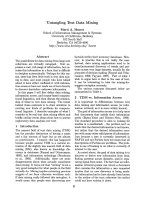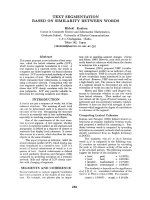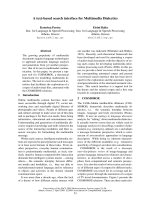Báo cáo khoa học: "Cross-Language Text Classification using Structural Correspondence Learning" pot
Bạn đang xem bản rút gọn của tài liệu. Xem và tải ngay bản đầy đủ của tài liệu tại đây (559.26 KB, 10 trang )
Proceedings of the 48th Annual Meeting of the Association for Computational Linguistics, pages 1118–1127,
Uppsala, Sweden, 11-16 July 2010.
c
2010 Association for Computational Linguistics
Cross-Language Text Classification
using Structural Correspondence Learning
Peter Prettenhofer and Benno Stein
Bauhaus-Universit
¨
at Weimar
D-99421 Weimar, Germany
{peter.prettenhofer,benno.stein}@uni-weimar.de
Abstract
We present a new approach to cross-
language text classification that builds on
structural correspondence learning, a re-
cently proposed theory for domain adap-
tation. The approach uses unlabeled doc-
uments, along with a simple word trans-
lation oracle, in order to induce task-
specific, cross-lingual word correspon-
dences. We report on analyses that reveal
quantitative insights about the use of un-
labeled data and the complexity of inter-
language correspondence modeling.
We conduct experiments in the field
of cross-language sentiment classification,
employing English as source language,
and German, French, and Japanese as tar-
get languages. The results are convincing;
they demonstrate both the robustness and
the competitiveness of the presented ideas.
1 Introduction
This paper deals with cross-language text classifi-
cation problems. The solution of such problems
requires the transfer of classification knowledge
between two languages. Stated precisely: We are
given a text classification task γ in a target lan-
guage T for which no labeled documents are avail-
able. γ may be a spam filtering task, a topic cate-
gorization task, or a sentiment classification task.
In addition, we are given labeled documents for
the identical task in a different source language S.
Such type of cross-language text classification
problems are addressed by constructing a clas-
sifier f
S
with training documents written in S
and by applying f
S
to unlabeled documents writ-
ten in T . For the application of f
S
under lan-
guage T different approaches are current practice:
machine translation of unlabeled documents from
T to S, dictionary-based translation of unlabeled
documents from T to S, or language-independent
concept modeling by means of comparable cor-
pora. The mentioned approaches have their pros
and cons, some of which are discussed below.
Here we propose a different approach to cross-
language text classification which adopts ideas
from the field of multi-task learning (Ando and
Zhang, 2005a). Our approach builds upon struc-
tural correspondence learning, SCL, a recently
proposed theory for domain adaptation in the
field of natural language processing (Blitzer et al.,
2006).
Similar to SCL, our approach induces corre-
spondences among the words from both languages
by means of a small number of so-called pivots. In
our context a pivot is a pair of words, {w
S
, w
T
},
from the source language S and the target lan-
guage T , which possess a similar semantics. Test-
ing the occurrence of w
S
or w
T
in a set of unla-
beled documents from S and T yields two equiv-
alence classes across these languages: one class
contains the documents where either w
S
or w
T
oc-
cur, the other class contains the documents where
neither w
S
nor w
T
occur. Ideally, a pivot splits
the set of unlabeled documents with respect to the
semantics that is associated with {w
S
, w
T
}. The
correlation between w
S
or w
T
and other words w,
w ∈ {w
S
, w
T
} is modeled by a linear classifier,
which then is used as a language-independent pre-
dictor for the two equivalence classes. As we will
see, a small number of pivots can capture a suffi-
ciently large part of the correspondences between
S and T in order to (1) construct a cross-lingual
representation and (2) learn a classifier f
ST
for the
task γ that operates on this representation. Several
advantages follow from our approach:
• Task specificity. The approach exploits the
words’ pragmatics since it considers—during
the pivot selection step—task-specific char-
acteristics of language use.
1118
• Efficiency in terms of linguistic resources.
The approach uses unlabeled documents
from both languages along with a small num-
ber (100 - 500) of translated words, instead
of employing a parallel corpus or an exten-
sive bilingual dictionary.
• Efficiency in terms of computing resources.
The approach solves the classification prob-
lem directly, instead of resorting to a more
general and potentially much harder problem
such as machine translation. Note that the use
of such technology is prohibited in certain sit-
uations (market competitors) or restricted by
environmental constraints (offline situations,
high latency, bandwidth capacity).
Contributions Our contributions to the outlined
field are threefold: First, the identification and uti-
lization of the theory of SCL to cross-language
text classification, which has, to the best of our
knowledge, not been investigated before. Sec-
ond, the further development and adaptation of
SCL towards a technology that is competitive with
the state-of-the-art in cross-language text classifi-
cation. Third, an in-depth analysis with respect
to important hyperparameters such as the ratio
of labeled and unlabeled documents, the number
of pivots, and the optimum dimensionality of the
cross-lingual representation. In this connection we
compile extensive corpora in the languages En-
glish, German, French, and Japanese, and for dif-
ferent sentiment classification tasks.
The paper is organized as follows: Section 2
surveys related work. Section 3 states the termi-
nology for cross-language text classification. Sec-
tion 4 describes our main contribution, a new ap-
proach to cross-language text classification based
on structural correspondence learning. Section 5
presents experimental results in the context of
cross-language sentiment classification.
2 Related Work
Cross-Language Text Classification Bel et al.
(2003) belong to the first who explicitly consid-
ered the problem of cross-language text classi-
fication. Their research, however, is predated
by work in cross-language information retrieval,
CLIR, where similar problems are addressed
(Oard, 1998). Traditional approaches to cross-
language text classification and CLIR use linguis-
tic resources such as bilingual dictionaries or par-
allel corpora to induce correspondences between
two languages (Lavrenko et al., 2002; Olsson et
al., 2005). Dumais et al. (1997) is considered as
seminal work in CLIR: they propose a method
which induces semantic correspondences between
two languages by performing latent semantic anal-
ysis, LSA, on a parallel corpus. Li and Taylor
(2007) improve upon this method by employing
kernel canonical correlation analysis, CCA, in-
stead of LSA. The major limitation of these ap-
proaches is their computational complexity and,
in particular, the dependence on a parallel cor-
pus, which is hard to obtain—especially for less
resource-rich languages. Gliozzo and Strappar-
ava (2005) circumvent the dependence on a par-
allel corpus by using so-called multilingual do-
main models, which can be acquired from com-
parable corpora in an unsupervised manner. In
(Gliozzo and Strapparava, 2006) they show for
particular tasks that their approach can achieve a
performance close to that of monolingual text clas-
sification.
Recent work in cross-language text classifica-
tion focuses on the use of automatic machine
translation technology. Most of these methods in-
volve two steps: (1) translation of the documents
into the source or the target language, and (2) di-
mensionality reduction or semi-supervised learn-
ing to reduce the noise introduced by the ma-
chine translation. Methods which follow this two-
step approach include the EM-based approach by
Rigutini et al. (2005), the CCA approach by For-
tuna and Shawe-Taylor (2005), the information
bottleneck approach by Ling et al. (2008), and the
co-training approach by Wan (2009).
Domain Adaptation Domain adaptation refers
to the problem of adapting a statistical classifier
trained on data from one (or more) source domains
(e.g., newswire texts) to a different target domain
(e.g., legal texts). In the basic domain adaptation
setting we are given labeled data from the source
domain and unlabeled data from the target domain,
and the goal is to train a classifier for the target
domain. Beyond this setting one can further dis-
tinguish whether a small amount of labeled data
from the target domain is available (Daume, 2007;
Finkel and Manning, 2009) or not (Blitzer et al.,
2006; Jiang and Zhai, 2007). The latter setting is
referred to as unsupervised domain adaptation.
1119
Note that, cross-language text classification
can be cast as an unsupervised domain adapta-
tion problem by considering each language as a
separate domain. Blitzer et al. (2006) propose
an effective algorithm for unsupervised domain
adaptation, called structural correspondence learn-
ing. First, SCL identifies features that general-
ize across domains, which the authors call pivots.
SCL then models the correlation between the piv-
ots and all other features by training linear clas-
sifiers on the unlabeled data from both domains.
This information is used to induce correspon-
dences among features from the different domains
and to learn a shared representation that is mean-
ingful across both domains. SCL is related to the
structural learning paradigm introduced by Ando
and Zhang (2005a). The basic idea of structural
learning is to constrain the hypothesis space of a
learning task by considering multiple different but
related tasks on the same input space. Ando and
Zhang (2005b) present a semi-supervised learning
method based on this paradigm, which generates
related tasks from unlabeled data. Quattoni et al.
(2007) apply structural learning to image classifi-
cation in settings where little labeled data is given.
3 Cross-Language Text Classification
This section introduces basic models and termi-
nology.
In standard text classification, a document d
is represented under the bag-of-words model as
|V |-dimensional feature vector x ∈ X, where V ,
the vocabulary, denotes an ordered set of words,
x
i
∈ x denotes the normalized frequency of word
i in d, and X is an inner product space. D
S
denotes the training set and comprises tuples of
the form (x, y), which associate a feature vector
x ∈ X with a class label y ∈ Y . The goal is to
find a classifier f : X → Y that predicts the la-
bels of new, previously unseen documents. With-
out loss of generality we restrict ourselves to bi-
nary classification problems and linear classifiers,
i.e., Y = {+1, -1} and f(x) = sign(w
T
x). w is a
weight vector that parameterizes the classifier, [·]
T
denotes the matrix transpose. The computation of
w from D
S
is referred to as model estimation or
training. A common choice for w is given by a
vector w
∗
that minimizes the regularized training
error:
w
∗
= argmin
w∈R
|V |
(x,y)∈D
S
L(y, w
T
x) +
λ
2
w
2
(1)
L is a loss function that measures the quality
of the classifier, λ is a non-negative regulariza-
tion parameter that penalizes model complexity,
and w
2
= w
T
w. Different choices for L entail
different classifier types; e.g., when choosing the
hinge loss function for L one obtains the popular
Support Vector Machine classifier (Zhang, 2004).
Standard text classification distinguishes be-
tween labeled (training) documents and unlabeled
(test) documents. Cross-language text classifica-
tion poses an extra constraint in that training doc-
uments and test documents are written in different
languages. Here, the language of the training doc-
uments is referred to as source language S, and
the language of the test documents is referred to as
target language T . The vocabulary V divides into
V
S
and V
T
, called vocabulary of the source lan-
guage and vocabulary of the target language, with
V
S
∩ V
T
= ∅. I.e., documents from the training
set and the test set map on two non-overlapping
regions of the feature space. Thus, a linear classi-
fier f
S
trained on D
S
associates non-zero weights
only with words from V
S
, which in turn means that
f
S
cannot be used to classify documents written
in T .
One way to overcome this “feature barrier” is
to find a cross-lingual representation for docu-
ments written in S and T , which enables the trans-
fer of classification knowledge between the two
languages. Intuitively, one can understand such
a cross-lingual representation as a concept space
that underlies both languages. In the following,
we will use θ to denote a map that associates the
original |V |-dimensional representation of a doc-
ument d written in S or T with its cross-lingual
representation. Once such a mapping is found the
cross-language text classification problem reduces
to a standard classification problem in the cross-
lingual space. Note that the existing methods for
cross-language text classification can be character-
ized by the way θ is constructed. For instance,
cross-language latent semantic indexing (Dumais
et al., 1997) and cross-language explicit semantic
analysis (Potthast et al., 2008) estimate θ using a
parallel corpus. Other methods use linguistic re-
sources such as a bilingual dictionary to obtain θ
(Bel et al., 2003; Olsson et al., 2005).
1120
4 Cross-Language
Structural Correspondence Learning
We now present a novel method for learning a
map θ by exploiting relations from unlabeled doc-
uments written in S and T . The proposed method,
which we call cross-language structural corre-
spondence learning, CL-SCL, addresses the fol-
lowing learning setup (see also Figure 1):
• Given a set of labeled training documents D
S
written in language S, the goal is to create a
text classifier for documents written in a dif-
ferent language T . We refer to this classifi-
cation task as the target task. An example for
the target task is the determination of senti-
ment polarity, either positive or negative, of
book reviews written in German (T ) given a
set of training reviews written in English (S).
• In addition to the labeled training docu-
ments D
S
we have access to unlabeled doc-
uments D
S,u
and D
T ,u
from both languages
S and T . Let D
u
denote D
S,u
∪ D
T ,u
.
• Finally, we are given a budget of calls to a
word translation oracle (e.g., a domain ex-
pert) to map words in the source vocabu-
lary V
S
to their corresponding translations in
the target vocabulary V
T
. For simplicity and
without loss of applicability we assume here
that the word translation oracle maps each
word in V
S
to exactly one word in V
T
.
CL-SCL comprises three steps: In the first step,
CL-SCL selects word pairs {w
S
, w
T
}, called piv-
ots, where w
S
∈ V
S
and w
T
∈ V
T
. Pivots have to
satisfy the following conditions:
Confidence Both words, w
S
and w
T
, are predic-
tive for the target task.
Support Both words, w
S
and w
T
, occur fre-
quently in D
S,u
and D
T ,u
respectively.
The confidence condition ensures that, in the
second step of CL-SCL, only those correlations
are modeled that are useful for discriminative
learning. The support condition, on the other
hand, ensures that these correlations can be es-
timated accurately. Considering our sentiment
classification example, the word pair {excellent
S
,
exzellent
T
} satisfies both conditions: (1) the
words are strong indicators of positive sentiment,
Words in V
S
Class
label
term frequencies
Negative class label
Positive class label
Words in V
T
, x
|V|
)x = (x
1
,
D
S
D
S,u
D
T,u
D
u
No value
y
Figure 1: The document sets underlying CL-SCL.
The subscripts
S
,
T
, and
u
designate “source lan-
guage”, “target language”, and “unlabeled”.
and (2) the words occur frequently in book reviews
from both languages. Note that the support of w
S
and w
T
can be determined from the unlabeled data
D
u
. The confidence, however, can only be deter-
mined for w
S
since the setting gives us access to
labeled data from S only.
We use the following heuristic to form an or-
dered set P of pivots: First, we choose a subset
V
P
from the source vocabulary V
S
, |V
P
| |V
S
|,
which contains those words with the highest mu-
tual information with respect to the class label of
the target task in D
S
. Second, for each word
w
S
∈ V
P
we find its translation in the target vo-
cabulary V
T
by querying the translation oracle; we
refer to the resulting set of word pairs as the can-
didate pivots, P
:
P
= {{w
S
, TRANSLATE(w
S
)} | w
S
∈ V
P
}
We then enforce the support condition by elim-
inating in P
all candidate pivots {w
S
, w
T
} where
the document frequency of w
S
in D
S,u
or of w
T
in D
T ,u
is smaller than some threshold φ:
P = CANDIDATEELIMINATION(P
, φ)
Let m denote |P |, the number of pivots.
In the second step, CL-SCL models the corre-
lations between each pivot {w
S
, w
T
} ∈ P and all
other words w ∈ V \ {w
S
, w
T
}. This is done by
training linear classifiers that predict whether or
not w
S
or w
T
occur in a document, based on the
other words. For this purpose a training set D
l
is
created for each pivot p
l
∈ P :
D
l
= {(MASK(x, p
l
), IN(x, p
l
)) | x ∈ D
u
}
1121
MASK(x, p
l
) is a function that returns a copy of
x where the components associated with the two
words in p
l
are set to zero—which is equivalent
to removing these words from the feature space.
IN(x, p
l
) returns +1 if one of the components of x
associated with the words in p
l
is non-zero and -1
otherwise. For each D
l
a linear classifier, charac-
terized by the parameter vector w
l
, is trained by
minimizing Equation (1) on D
l
. Note that each
training set D
l
contains documents from both lan-
guages. Thus, for a pivot p
l
= {w
S
, w
T
} the vec-
tor w
l
captures both the correlation between w
S
and V
S
\ {w
S
} and the correlation between w
T
and V
T
\ {w
T
}.
In the third step, CL-SCL identifies correlations
across pivots by computing the singular value de-
composition of the |V |×m-dimensional parameter
matrix W, W =
w
1
. . . w
m
:
UΣV
T
= SVD(W)
Recall that W encodes the correlation structure
between pivot and non-pivot words in the form
of multiple linear classifiers. Thus, the columns
of U identify common substructures among these
classifiers. Choosing the columns of U associated
with the largest singular values yields those sub-
structures that capture most of the correlation in
W. We define θ as those columns of U that are
associated with the k largest singular values:
θ = U
T
[1:k, 1:|V |]
Algorithm 1 summarizes the three steps of CL-
SCL. At training and test time, we apply the pro-
jection θ to each input instance x. The vector v
∗
that minimizes the regularized training error for
D
S
in the projected space is defined as follows:
v
∗
= argmin
v∈R
k
(x,y)∈D
S
L(y, v
T
θx) +
λ
2
v
2
(2)
The resulting classifier f
ST
, which will operate
in the cross-lingual setting, is defined as follows:
f
ST
(x) = sign(v
∗T
θx)
4.1 An Alternative View of CL-SCL
An alternative view of cross-language structural
correspondence learning is provided by the frame-
work of structural learning (Ando and Zhang,
2005a). The basic idea of structural learning is
Algorithm 1 CL-SCL
Input:
Labeled source data D
S
Unlabeled data D
u
= D
S,u
∪ D
T ,u
Parameters:
m, k, λ, and φ
Output:
k × |V |-dimensional matrix θ
1. SELECTPIVOTS(D
S
, m)
V
P
= MUTUALINFORMATION(D
S
)
P
= {{w
S
, TRANSLATE(w
S
)} | w
S
∈ V
P
}
P = CANDIDATEELIMINATION(P
, φ)
2. TRAINPIVOTPREDICTORS(D
u
, P )
for l = 1 to m do
D
l
= {(MASK(x, p
l
), IN(x, p
l
)) | x ∈ D
u
}
w
l
= argmin
w∈R
|V |
(x,y)∈D
l
L(y, w
T
x)) +
λ
2
w
2
end for
W =
w
1
. . . w
m
3. COMPUTESVD(W, k)
UΣV
T
= SVD(W)
θ = U
T
[1:k, 1:|V |]
output {θ}
to constrain the hypothesis space, i.e., the space of
possible weight vectors, of the target task by con-
sidering multiple different but related prediction
tasks. In our context these auxiliary tasks are rep-
resented by the pivot predictors, i.e., the columns
of W. Each column vector w
l
can be considered
as a linear classifier which performs well in both
languages. I.e., we regard the column space of W
as an approximation to the subspace of bilingual
classifiers. By computing SVD(W) one obtains
a compact representation of this column space in
the form of an orthonormal basis θ
T
.
The subspace is used to constrain the learning of
the target task by restricting the weight vector w to
lie in the subspace defined by θ
T
. Following Ando
and Zhang (2005a) and Quattoni et al. (2007) we
choose w for the target task to be w
∗
= θ
T
v
∗
,
where v
∗
is defined as follows:
v
∗
= argmin
v∈R
k
(x,y)∈D
S
L(y, (θ
T
v)
T
x) +
λ
2
v
2
(3)
Since (θ
T
v)
T
= v
T
θ it follows that this view
of CL-SCL corresponds to the induction of a new
feature space given by Equation 2.
1122
5 Experiments
We evaluate CL-SCL for the task of cross-
language sentiment classification using English
as source language and German, French, and
Japanese as target languages. Special emphasis is
put on corpus construction, determination of upper
bounds and baselines, and a sensitivity analysis of
important hyperparameters. All data described in
the following is publicly available from our project
website.
1
5.1 Dataset and Preprocessing
We compiled a new dataset for cross-language
sentiment classification by crawling product re-
views from Amazon.{de | fr | co.jp}. The crawled
part of the corpus contains more than 4 million
reviews in the three languages German, French,
and Japanese. The corpus is extended with En-
glish product reviews provided by Blitzer et al.
(2007). Each review contains a category label,
a title, the review text, and a rating of 1-5 stars.
Following Blitzer et al. (2007) a review with >3
(<3) stars is labeled as positive (negative); other
reviews are discarded. For each language the la-
beled reviews are grouped according to their cate-
gory label, whereas we restrict our experiments to
three categories: books, dvds, and music.
Since most of the crawled reviews are posi-
tive (80%), we decide to balance the number of
positive and negative reviews. In this study, we
are interested in whether the cross-lingual repre-
sentation induced by CL-SCL captures the differ-
ence between positive and negative reviews; by
balancing the reviews we ensure that the imbal-
ance does not affect the learned model. Balancing
is achieved by deleting reviews from the major-
ity class uniformly at random for each language-
specific category. The resulting sets are split into
three disjoint, balanced sets, containing training
documents, test documents, and unlabeled docu-
ments; the respective set sizes are 2,000, 2,000,
and 9,000-50,000. See Table 1 for details.
For each of the nine target-language-category-
combinations a text classification task is created
by taking the training set of the product category in
S and the test set of the same product category in
T . A document d is described as normalized fea-
ture vector x under a unigram bag-of-words docu-
ment representation. The morphological analyzer
1
/>webis-cls-10/
MeCab is used for Japanese word segmentation.
2
5.2 Implementation
Throughout the experiments linear classifiers are
employed; they are trained by minimizing Equa-
tion (1), using a stochastic gradient descent (SGD)
algorithm. In particular, the learning rate schedule
from PEGASOS is adopted (Shalev-Shwartz et al.,
2007), and the modified Huber loss, introduced by
Zhang (2004), is chosen as loss function L.
3
SGD receives two hyperparameters as input: the
number of iterations T , and the regularization pa-
rameter λ. In our experiments T is always set to
10
6
, which is about the number of iterations re-
quired for SGD to converge. For the target task,
λ is determined by 3-fold cross-validation, testing
for λ all values 10
−i
, i ∈ [0; 6]. For the pivot pre-
diction task, λ is set to the small value of 10
−5
, in
order to favor model accuracy over generalizabil-
ity.
The computational bottleneck of CL-SCL is the
SVD of the dense parameter matrix W. Here we
follow Blitzer et al. (2006) and set the negative
values in W to zero, which yields a sparse repre-
sentation. For the SVD computation the Lanczos
algorithm provided by SVDLIBC is employed.
4
We investigated an alternative approach to obtain
a sparse W by directly enforcing sparse pivot pre-
dictors w
l
through L1-regularization (Tsuruoka et
al., 2009), but didn’t pursue this strategy due to
unstable results. Since SGD is sensitive to fea-
ture scaling the projection θx is post-processed as
follows: (1) Each feature of the cross-lingual rep-
resentation is standardized to zero mean and unit
variance, where mean and variance are estimated
on D
S
∪ D
u
. (2) The cross-lingual document rep-
resentations are scaled by a constant α such that
|D
S
|
−1
x∈D
S
αθx = 1.
We use Google Translate as word translation or-
acle, which returns a single translation for each
query word.
5
Though such a context free transla-
tion is suboptimum we do not sanitize the returned
words to demonstrate the robustness of CL-SCL
with respect to translation noise. To ensure the re-
producibility of our results we cache all queries to
the translation oracle.
2
3
Our implementation is available at http://github.
com/pprett/bolt
4
/>˜
dr/SVDLIBC/
5
1123
T Category
Unlabeled data Upper Bound CL-MT CL-SCL
|D
S,u
| |D
T ,u
| µ σ µ σ ∆ µ σ ∆
books 50,000 50,000 83.79 (±0.20) 79.68 (±0.13) 4.11 79.50 (±0.33) 4.29
German dvd 30,000 50,000 81.78 (±0.27) 77.92 (±0.25) 3.86 76.92 (±0.07) 4.86
music 25,000 50,000 82.80 (±0.13) 77.22 (±0.23) 5.58 77.79 (±0.02) 5.00
books 50,000 32,000 83.92 (±0.14) 80.76 (±0.34) 3.16 78.49 (±0.03) 5.43
French dvd 30,000 9,000 83.40 (±0.28) 78.83 (±0.19) 4.57 78.80 (±0.01) 4.60
music 25,000 16,000 86.09 (±0.13) 75.78 (±0.65) 10.31 77.92 (±0.03) 8.17
books 50,000 50,000 79.39 (±0.27) 70.22 (±0.27) 9.17 73.09 (±0.07) 6.30
Japanese dvd 30,000 50,000 81.56 (±0.28) 71.30 (±0.28) 10.26 71.07 (±0.02) 10.49
music 25,000 50,000 82.33 (±0.13) 72.02 (±0.29) 10.31 75.11 (±0.06) 7.22
Table 1: Cross-language sentiment classification results. For each task, the number of unlabeled docu-
ments from S and T is given. Accuracy scores (mean µ and standard deviation σ of 10 repetitions of
SGD) on the test set of the target language T are reported. ∆ gives the difference in accuracy to the
upper bound. CL-SCL uses m = 450, k = 100, and φ = 30.
5.3 Upper Bound and Baseline
To get an upper bound on the performance of
a cross-language method we first consider the
monolingual setting. For each target-language-
category-combination a linear classifier is learned
on the training set and tested on the test set. The
resulting accuracy scores are referred to as upper
bound; it informs us about the expected perfor-
mance on the target task if training data in the tar-
get language is available.
We chose a machine translation baseline
to compare CL-SCL to another cross-language
method. Statistical machine translation technol-
ogy offers a straightforward solution to the prob-
lem of cross-language text classification and has
been used in a number of cross-language senti-
ment classification studies (Hiroshi et al., 2004;
Bautin et al., 2008; Wan, 2009). Our baseline
CL-MT works as follows: (1) learn a linear clas-
sifier on the training data, and (2) translate the test
documents into the source language,
6
(3) predict
6
Again we use Google Translate.
the sentiment polarity of the translated test doc-
uments. Note that the baseline CL-MT does not
make use of unlabeled documents.
5.4 Performance Results and Sensitivity
Table 1 contrasts the classification performance of
CL-SCL with the upper bound and with the base-
line. Observe that the upper bound does not ex-
hibit a great variability across the three languages.
The average accuracy is about 82%, which is con-
sistent with prior work on monolingual sentiment
analysis (Pang et al., 2002; Blitzer et al., 2007).
The performance of CL-MT, however, differs con-
siderably between the two European languages
and Japanese: for Japanese, the average difference
between the upper bound and CL-MT (9.9%) is
about twice as much as for German and French
(5.3%). This difference can be explained by the
fact that machine translation works better for Eu-
ropean than for Asian languages such as Japanese.
Recall that CL-SCL receives three hyperparam-
eters as input: the number of pivots m, the di-
mensionality of the cross-lingual representation k,
Pivot
English German
Semantics Pragmatics Semantics Pragmatics
{beautiful
S
, sch
¨
on
T
} amazing, beauty, picture, pattern, poetry, sch
¨
oner (more beautiful), bilder (pictures),
lovely photographs, paintings traurig (sad) illustriert (illustrated)
{boring
S
, langweilig
T
} plain, asleep, characters, pages, langatmig (lengthy), charaktere (characters),
dry, long story einfach (plain), handlung (plot),
entt
¨
auscht (disappointed) seiten (pages)
Table 2: Semantic and pragmatic correlations identified for the two pivots {beautiful
S
, sch
¨
on
T
} and
{boring
S
, langweilig
T
} in English and German book reviews.
1124
Figure 2: Influence of unlabeled data and hyperparameters on the performance of CL-SCL. The rows
show the performance of CL-SCL as a function of (1) the ratio between labeled and unlabeled documents,
(2) the number of pivots m, and (3) the dimensionality of the cross-lingual representation k.
and the minimum support φ of a pivot in D
S,u
and D
T ,u
. For comparison purposes we use fixed
values of m = 450, k = 100, and φ = 30.
The results show the competitiveness of CL-SCL
compared to CL-MT. Although CL-MT outper-
forms CL-SCL on most tasks for German and
French, the difference in accuracy can be consid-
ered as small (<1%); merely for French book and
music reviews the difference is about 2%. For
Japanese, however, CL-SCL outperforms CL-MT
on most tasks with a difference in accuracy of
about 3%. The results indicate that if the dif-
ference between the upper bound and CL-MT is
large, CL-SCL can circumvent the loss in accu-
racy. Experiments with language-specific settings
revealed that for Japanese a smaller number of piv-
ots (150<m<250) performs significantly better.
Thus, the reported results for Japanese can be con-
sidered as pessimistic.
Primarily responsible for the effectiveness of
CL-SCL is its task specificity, i.e., the ways in
which context contributes to meaning (pragmat-
ics). Due to the use of task-specific, unlabeled
data, relevant characteristics are captured by the
pivot classifiers. Table 2 exemplifies this with two
pivots for German book reviews. The rows of the
table show those words which have the highest
correlation with the pivots {beautiful
S
, sch
¨
on
T
}
and {boring
S
, langweilig
T
}. We can distinguish
between (1) correlations that reflect similar mean-
ing, such as “amazing”, “lovely”, or “plain”, and
(2) correlations that reflect the pivot pragmatics
with respect to the task, such as “picture”, “po-
etry”, or “pages”. Note in this connection that au-
thors of book reviews tend to use the word “beau-
tiful” to refer to illustrations or poetry. While the
first type of word correlations can be obtained by
methods that operate on parallel corpora, the sec-
ond type of correlation requires an understanding
of the task-specific language use.
In the following we discuss the sensitivity of
each hyperparameter in isolation while keeping
1125
the others fixed at m = 450, k = 100, and φ = 30.
The experiments are illustrated in Figure 2.
Unlabeled Data The first row of Figure 2 shows
the performance of CL-SCL as a function of the
ratio of labeled and unlabeled documents. A ratio
of 1 means that |D
S,u
| = |D
T ,u
| = 2,000, while
a ratio of 25 corresponds to the setting of Table 1.
As expected, an increase in unlabeled documents
results in an improved performance, however, we
observe a saturation at a ratio of 10 across all nine
tasks.
Number of Pivots The second row shows the in-
fluence of the number of pivots m on the perfor-
mance of CL-SCL. Compared to the size of the
vocabularies V
S
and V
T
, which is in 10
5
order
of magnitude, the number of pivots is very small.
The plots show that even a small number of piv-
ots captures a significant amount of the correspon-
dence between S and T .
Dimensionality of the Cross-Lingual Represen-
tation The third row shows the influence of the
dimensionality of the cross-lingual representation
k on the performance of CL-SCL. Obviously the
SVD is crucial to the success of CL-SCL if m
is sufficiently large. Observe that the value of k
is task-insensitive: a value of 75<k<150 works
equally well across all tasks.
6 Conclusion
The paper introduces a novel approach to cross-
language text classification, called cross-language
structural correspondence learning. The approach
uses unlabeled documents along with a word
translation oracle to automatically induce task-
specific, cross-lingual correspondences. Our con-
tributions include the adaptation of SCL for the
problem of cross-language text classification and
a well-founded empirical analysis. The analy-
sis covers performance and robustness issues in
the context of cross-language sentiment classifica-
tion with English as source language and German,
French, and Japanese as target languages. The re-
sults show that CL-SCL is competitive with state-
of-the-art machine translation technology while
requiring fewer resources.
Future work includes the extension of CL-SCL
towards a general approach for cross-lingual adap-
tation of natural language processing technology.
References
Rie-K. Ando and Tong Zhang. 2005a. A framework
for learning predictive structures from multiple tasks
and unlabeled data. J. Mach. Learn. Res., 6:1817–
1853.
Rie-K. Ando and Tong Zhang. 2005b. A high-
performance semi-supervised learning method for
text chunking. In Proceedings of ACL-05, pages 1–
9, Ann Arbor.
Mikhail Bautin, Lohit Vijayarenu, and Steven Skiena.
2008. International sentiment analysis for news and
blogs. In Proceedings of ICWSM-08, pages 19–26,
Seattle.
Nuria Bel, Cornelis H. A. Koster, and Marta Villegas.
2003. Cross-lingual text categorization. In Proceed-
ings of ECDL-03, pages 126–139, Trondheim.
John Blitzer, Ryan McDonald, and Fernando Pereira.
2006. Domain adaptation with structural corre-
spondence learning. In Proceedings of EMNLP-06,
pages 120–128, Sydney.
John Blitzer, Mark Dredze, and Fernando Pereira.
2007. Biographies, bollywood, boom-boxes and
blenders: Domain adaptation for sentiment classi-
fication. In Proceedings of ACL-07, pages 440–447,
Prague.
Hal Daum
´
e III. 2007. Frustratingly easy domain adap-
tation. In Proceedings of ACL-07, pages 256–263,
Prague.
Susan T. Dumais, Todd A. Letsche, Michael L.
Littman, and Thomas K. Landauer. 1997. Auto-
matic cross-language retrieval using latent semantic
indexing. In AAAI Symposium on CrossLanguage
Text and Speech Retrieval.
Jenny-R. Finkel and Christopher-D. Manning. 2009.
Hierarchical bayesian domain adaptation. In Pro-
ceedings of HLT/NAACL-09, pages 602–610, Boul-
der.
Bla
ˇ
z Fortuna and John Shawe-Taylor. 2005. The use
of machine translation tools for cross-lingual text
mining. In Proceedings of the ICML Workshop on
Learning with Multiple Views.
Alfio Gliozzo and Carlo Strapparava. 2005. Cross lan-
guage text categorization by acquiring multilingual
domain models from comparable corpora. In Pro-
ceedings of the ACL Workshop on Building and Us-
ing Parallel Texts.
Alfio Gliozzo and Carlo Strapparava. 2006. Exploit-
ing comparable corpora and bilingual dictionaries
for cross-language text categorization. In Proceed-
ings of ACL-06, pages 553–560, Sydney.
Kanayama Hiroshi, Nasukawa Tetsuya, and Watanabe
Hideo. 2004. Deeper sentiment analysis using
machine translation technology. In Proceedings of
COLING-04, pages 494–500, Geneva.
1126
Jing Jiang and Chengxiang Zhai. 2007. A two-stage
approach to domain adaptation for statistical classi-
fiers. In Proceedings of CIKM-07, pages 401–410,
Lisbon.
Victor Lavrenko, Martin Choquette, and W. Bruce
Croft. 2002. Cross-lingual relevance models. In
Proceedings of SIGIR-02, pages 175–182, Tampere.
Yaoyong Li and John S. Taylor. 2007. Advanced
learning algorithms for cross-language patent re-
trieval and classification. Inf. Process. Manage.,
43(5):1183–1199.
Xiao Ling, Gui-R. Xue, Wenyuan Dai, Yun Jiang,
Qiang Yang, and Yong Yu. 2008. Can chinese web
pages be classified with english data source? In Pro-
ceedings of WWW-08, pages 969–978, Beijing.
Douglas W. Oard. 1998. A comparative study of query
and document translation for cross-language infor-
mation retrieval. In Proceedings of AMTA-98, pages
472–483, Langhorne.
J. Scott Olsson, Douglas W. Oard, and Jan Haji
ˇ
c. 2005.
Cross-language text classification. In Proceedings
of SIGIR-05, pages 645–646, Salvador.
Bo Pang, Lillian Lee, and Shivakumar Vaithyanathan.
2002. Thumbs up?: sentiment classification us-
ing machine learning techniques. In Proceedings of
EMNLP-02, pages 79–86, Philadelphia.
Martin Potthast, Benno Stein, and Maik Anderka.
2008. A wikipedia-based multilingual retrieval
model. In Proceedings of ECIR-08, pages 522–530,
Glasgow.
Ariadna Quattoni, Michael Collins, and Trevor Darrell.
2007. Learning visual representations using images
with captions. In Proceedings of CVPR-07, pages
1–8, Minneapolis.
Leonardo Rigutini, Marco Maggini, and Bing Liu.
2005. An em based training algorithm for cross-
language text categorization. In Proceedings of WI-
05, pages 529–535, Compi
`
egne.
Shai Shalev-Shwartz, Yoram Singer, and Nathan Sre-
bro. 2007. Pegasos: Primal estimated sub-gradient
solver for svm. In Proceedings of ICML-07, pages
807–814, Corvalis.
Yoshimasa Tsuruoka, Jun’ichi Tsujii, and Sophia Ana-
niadou. 2009. Stochastic gradient descent training
for l1-regularized log-linear models with cumulative
penalty. In Proceedings of ACL/AFNLP-09, pages
477–485, Singapore.
Xiaojun Wan. 2009. Co-training for cross-
lingual sentiment classification. In Proceedings of
ACL/AFNLP-09, pages 235–243, Singapore.
Tong Zhang. 2004. Solving large scale linear predic-
tion problems using stochastic gradient descent al-
gorithms. In Proceedings of ICML-04, pages 116–
124, Banff.
1127
